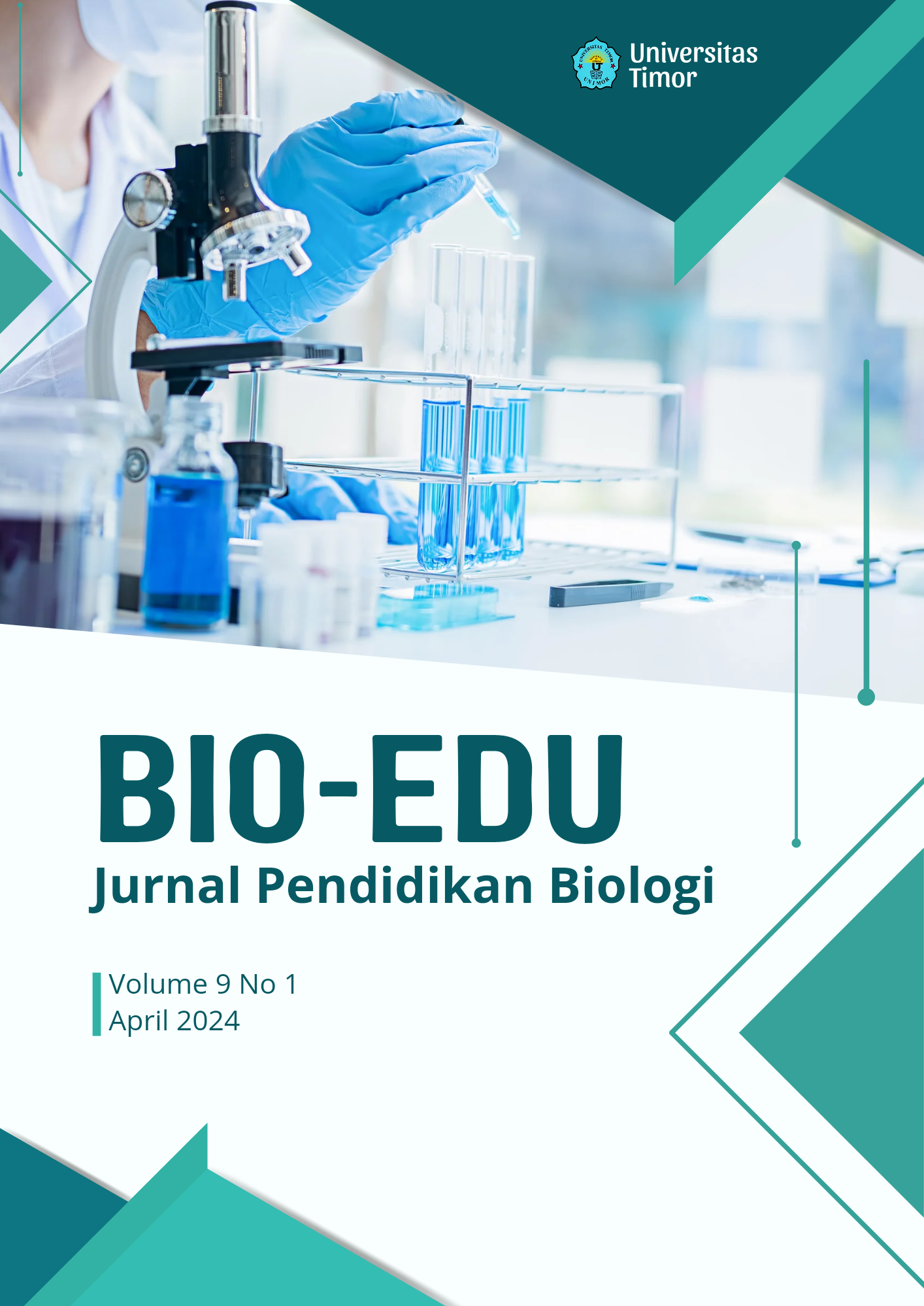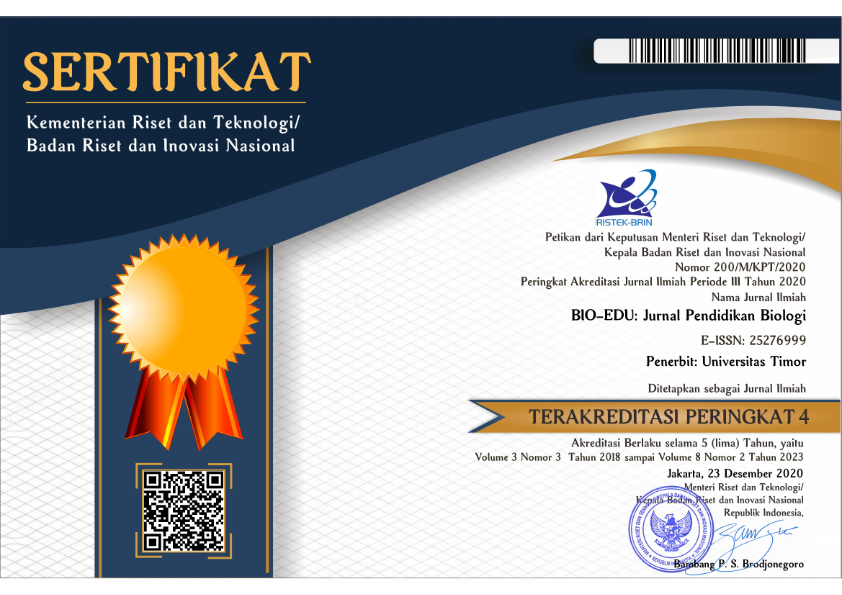Inventarisasi dan Studi Dispersal Gulma Asing Invasif di Kebun Biologi UIN Sunan Gunung Djati Bandung
DOI:
https://doi.org/10.32938/jbe.v9i1.5995Keywords:
Gulma Asing Invasif (GAI); Inventarisasi; Vektor Dispersal.Abstract
Invasive alien weeds are plant pests because they can interfere with the growth and productivity of surrounding plants. Studies of invasive alien weeds, inventory of species, and their dispersal are important not only in conservation environments but also in study areas in educational institutions such as universities. This research was conducted with the aim of being an initial study to determine the types and distribution vectors of invasive alien weeds in the study area of the biology garden of UIN Sunan Gunung Djati Bandung which have the potential to disrupt the surrounding ecosystem. Weed sampling was carried out by purposive sampling exploration method in the biology garden area of the Faculty of Science and Technology UIN Sunan Gunung Djati Bandung. Based on the inventory results, a total of 16 species and 8 families of invasive alien weeds were obtained with the most families coming from the Asteraceae family. The invasive alien weed seed dispersal vectors include wind, water, and animals. Most invasive alien weed species found in the sampling sites have wind and animal dispersal vector types (31.25%). Seed dispersal by animals and wind has an effective dispersal rate because the range of distribution is quite wide. In addition, the characteristics of seeds, the ability to adapt and develop in new environments in plants such as species of the Asteraceae family can cause their invasion to take place quickly and massively.
References
Ariyanto, D. P., Qudsi, Z. A., Sumani, Dewi, W. S., Rahayu, & Komariah. (2021). The dynamic effect of air temperature and air humidity toward soil temperature in various lands cover at KHDTK Gunung Bromo, Karanganyar-Indonesia. IOP Conference Series: Earth and Environmental Science, 724(1). doi: 10.1088/1755-1315/724/1/012003
Bolaji, A. O., Idowu-Aiye, M., & Moronfade, H. O. (2020). Reproductive biology of four weedy Euphorbia species from Ile-Ife, Nigeria. Ife Journal of Science, 22(1), 1–8. doi: 10.4314/ijs.v22i1.1
Brancalion, P., Novembre, A. D., Rodrigues, R., & Marcos-Filho, J. (2010). Dormancy as exaptation to protect mimetic seeds against deterioration before dispersal. Annals of botany, 105(6), 991-998. doi: 10.1093/aob/mcq068.
Bartz, R., & Kowarik, I. 2019. Assessing the Environmental Impacts of Invasive Alien Plants: A Review of Assessment Approaches. Neo Biota, 43(1), 69–99
Cahyaningprastiwi, S. R., Karyati, K., & Sarminah, S. (2021). Suhu dan Kelembapan Tanah pada Posisi Topografi dan Kedalaman Tanah Berbeda di Taman Sejati Kota Samarinda. Agrifor, 20(2), 189. doi: 10.31293/agrifor.v20i2.5231
Datiles, M. J., & Rodriguez, P. A. (2014). Abrus precatorius (rosary pea). doi: 10.1079/cabicompendium.1965
Dauer, J. T., Mortensen, D. A., & Vangessel, M. J. (2007). Temporal and spatial dynamics of long-distance Conyza canadensis seed dispersal. Journal of Applied Ecology, 44(1), 105–114. doi: 10.1111/j.1365-2664.2006.01256.x
Destaranti, N., Sulistyani, S., & Yani, E. (2017). Struktur dan Vegetasi Tumbuhan Bawah pada Tegakan Pinus di RPH Kalirajut dan RPH Baturraden Banyumas. Scripta Biologica, 4(3), 155. doi: 10.20884/1.sb.2017.4.3.407
Flores-Moreno, H., Thomson, F. J., Warton, D. I., & Moles, A. T. (2013) Are Introduced Species Better Dispersers Than Native Species? A Global Comparative Study of Seed Dispersal Distance. PLoS ONE, 8(6): e68541. doi: 10.1371/journal.pone.0068541
Haines, A. (2016). Addressing challenges to human health in the Anthropocene epoch-an overview of the findings of the Rockefeller/Lancet Commission on Planetary Health. Public health reviews, 37, 14. doi: 10.1186/s40985-016-0029-0
Hasanuddin. (2017). Jenis Vegetasi Moraceae di Kawasan Stasiun Ketambe Taman Nasional Gunung Leuseur Aceh Tenggara. Prosiding Seminar Nasional Biotik, 3(8), 12–20.
Karyati, K., Putri, R. O., & Syafrudin, M. (2018). Suhu dan Kelembapan Tanah pada Lahan Revegetasi Pasca Tambang di PT Adimitra Baratama Nusantara, Provinsi Kalimantan Timur. Agrifor, 17(1), 103. doi: 10.31293/af.v17i1.3280
Khamare, Y., Marble, S., Steed, S., & Boyd, N. (2019). Biology and Management of Spanish Needles (Bidens spp.) in Ornamental Crop Production. EDIS. doi: 10.32473/edis-ep572-2019.
Kumar-Rai, P., & Singh, J. S. (2020). Invasive alien plant species: Their impact on environment, ecosystem services and human health. Ecological indicators, 111, 106020. doi: 10.1016/j.ecolind.2019.106020
Ludovici, K. H. (2004). Encyclopedia of forest sciences. Choice Reviews Online, 42(04), 42-1941-42–1941. doi: 10.5860/choice.42-1941
Munim, A., Rod, M. R., Tavakoli, H., & Hosseinian, F. (2017). An Analysis of the Composition, Health Benefits, and Future Market Potential of the Jerusalem Artichoke in Canada. J. Food Res. 2017;6, 69. doi: 10.5539/jfr.v6n5p69.
Padmanaba, M., Tomlinson, K.W., Hughes, A.C., & Corlett, R. T. (2017). Alien plant invasions of protected areas in Java, Indonesia. Sci Rep, 7, 9334. doi: 10.1038/s41598-017-09768-z
Nascimento, C. E. S., da Silva, C. A. D., Leal, I. R., Tavares, W. S., Serrão, J. E., Zanuncio, J. C., & Tabarelli, M. (2020). Seed germination and early seedling survival of the invasive species Prosopis juliflora (Fabaceae) depend on habitat and seed dispersal mode in the Caatinga dry forest. PeerJ, 8, e9607. doi: 10.7717/peerj.9607
Prihatini, R., Syarif, A., & Bakhtiar, A. (2020). Morphology Character and Andrographolide Quantifications on Sambiloto ( Andrographis paniculata (Burm.F.) Nees) Karakter Morfologi dan Kuantifikasi Andrografolid Pada Sambiloto (Andrographis paniculata (Burm.F.) Nees ). Bioscience, 4(1), 109. doi: 10.24036/0202041107669-0-00
Putra, B. S. (2022). Jenis Tanaman Invasif dan Ancaman Terhadap Konservasi Satwa di Taman Nasional. Jurnal Natur Indonesia, 20(1), 24-29.
Putri, H. O., Rahayu Utami, S., & Kurniawan, S. (2019). Sifat Kimia Tanah Pada Berbagai Penggunaan Lahan di UB Forest. Jurnal Tanah Dan Sumberdaya Lahan, 6(1), 1075–1082.
Rahmita, R., Ramadanil, R., & Iqbal, Moh. (2019). Jenis-Jenis Tumbuhan Suku Fabaceae, Subfamili Caesalpinioideae Di Areal Kampus Universitas Tadulako, Palu. Natural Science: Journal of Science and Technology, 8(2). doi: 10.22487/25411969.2019.v8.i2.13542
Rani, D. (2022). Measuring Humidity impact on water content of soil. Jetir, 9(5), 1-6.
Rasiska, S., Sudarjat., Asdak, C., Parikesit., & Gunawan, B. (2023). Keanekaragaman Tumbuhan Bawah dan Implikasinya terhadap Serangga di Kawasan Budi Daya Tanaman di Kawah Kamojang, Kecamatan Ibun, Kabupaten Bandung, Jawa Barat. Jurnal Agrikultura, 34(2), 293-305.
Rasyid, A., Suleman, S. M., Lilies., & Achmad, M. A. (2020). Jenis dan Kerapatan Tumbuhan Invasif Alien Spesies (IAS) di Taman Hutan Raya (TAHURA) Kota Palu yang Diimplementasikan sebagai Media Pembelajaran. Journal of Biology Science and Education (JBSE), 8(2), 630-638.
Rolnik, A., & Olas, B. (2021). The Plants of the Asteraceae Family as Agents in the Protection of Human Health. International journal of molecular sciences, 22(6), 3009. doi: 10.3390/ijms22063009
Sayfulloh, A., Riniarti, M., & Santoso, T. (2020). Invasive Alien Species Plants in Sukaraja Atas Resort, Bukit Barisan Selatan National Park. Jurnal Sylva Lestari, 8(1), 109. 10.23960/jsl18109-120.
Setyawati, T., Narulita, S., Bahri, I. P., & Raharjo, G. T. (2015). A Guide Boook to Invasive Alien Plant Species in Indonesia. Indonesia: Research, Development, and Innovation Agency, Ministry of Environment and Forestry
Sitepu, B. S. (2020). Keragaman dan Pengendalian Tumbuhan Invasif di KHDTK Samboja, Kalimantan Timur. Jurnal Sylva Lestari, 8(3), 351-365.
Sulistijo, T. D., & Pujiasmanto, B. (2007). Identifikasi Sambiloto (Andrographis paniculata Ness) Sebagai Dasar Pemanfaatan dan Pelestarian Plasma Nutfah. Biodiversitas, 8(3), 218-222.
Sulistiyowati, H., Rahmawati, E., & Wimbaningrum, R. (2021). Pola Penyebaran Spasial Populasi Tumbuhan Asing Invasif Lantana Camara L. Di Kawasan Savana Pringtali Resort Bandealit Taman Nasional Meru Betiri. Jurnal Ilmu Dasar, 22(1), 19-24.
Tjitrosoedirjo, S., Setyawati, T., Sunardi., Subiakto, A., Irianto,R., & Garsetiasih, R. (2016). Pedoman Analisis Risiko Tumbuhan Asing Invasif (Pre Border). Bogor: FORIS Indonesia.
Tustiyani, I., Nurjanah, D. R., Maesyaroh, S. S., & Mutakin, J. (2019). Identifikasi keanekaragaman dan dominansi gulma pada lahan pertanaman jeruk (Citrus sp.). Kultivasi, 18(1), 779-783. doi: 10.24198/kultivasi.v18i1.18933
Veselova, T. D., Dzhalilova, K. K., Remizowa, M. V., & Timonin, A. C. (2012). Embryology of Talinum paniculatum (Jacq.) Gaertn. and T. triangulare (Jacq.) Willd. (Portulacaceae s.l., Caryophyllales). Wulfenia, 19, 107–129.
Yildirim H, Özdöl T, & H Yaşayacak. (2019). An alien species of Bidens (Asteraceae): Bidens pilosa L., new to the Turkish flora. Acta Biologica Turcica, 32(1) 61-64.
Zhang, K., Yao, L., Zhang, Y., & Tao, J. (2019). Achene heteromorphism in Bidens pilosa (Asteraceae): differences in germination and possible adaptive significance. AoB PLANTS, 11(3), plz026. doi: 10.1093/aobpla/plz026
Zhang, B., Hastings, A., Grosholz, E.D., & Zhai, L. (2023). The comparison of dispersal rate between invasive and native species varied by plant life form and functional traits. Mov Ecol, 11(73), 2-10. doi: 10.1186/s40462-023-00424-y
Downloads
Published
Issue
Section
License
The Authors submitting a manuscript do so on the understanding that if accepted for publication, the copyright of the article shall be assigned to BIO-EDU: Jurnal Pendidikan Biologi and Departement of Biology Education, Universitas Timor as the publisher of the journal. Copyright encompasses rights to reproduce and deliver the article in all form and media, including reprints, photographs, microfilms, and any other similar reproductions, as well as translations.
BIO-EDU journal and Departement Biology Education, Universitas Timor, and the Editors make every effort to ensure that no wrong or misleading data, opinions, or statements be published in the journal. In any way, the contents of the articles and advertisements published in BIO-EDU are the sole and responsibility of their respective authors and advertisers.
Users of this website will be licensed to use materials from this website following the Creative Commons Attribution-ShareAlike 4.0 International License.



















